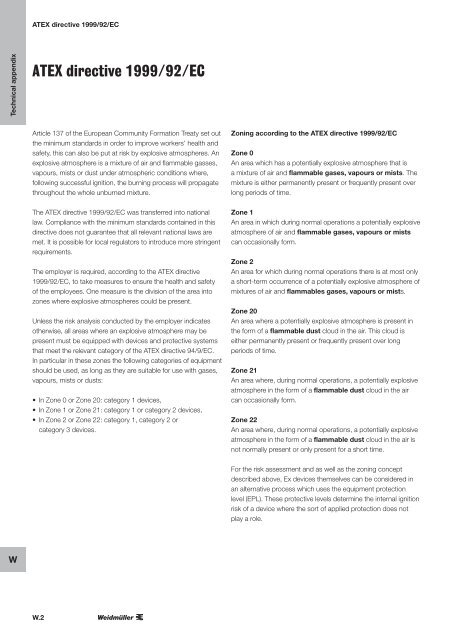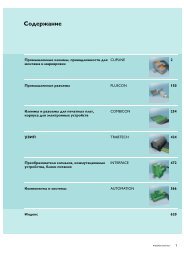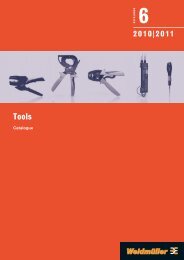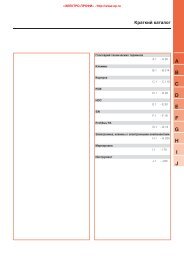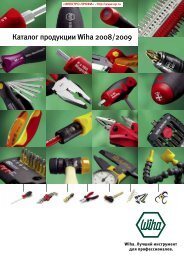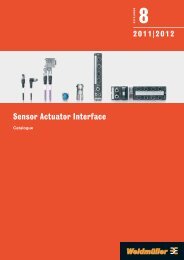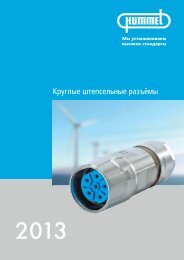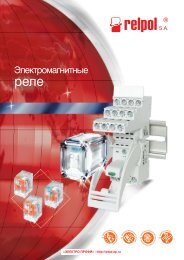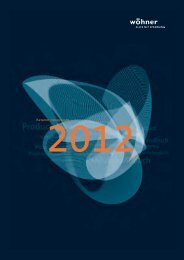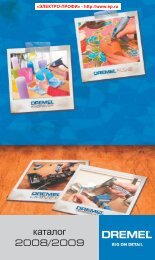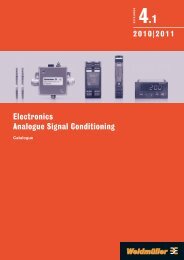ÐаÑалог Weidmuller: Enclosures and Cable Glands
ÐаÑалог Weidmuller: Enclosures and Cable Glands
ÐаÑалог Weidmuller: Enclosures and Cable Glands
Create successful ePaper yourself
Turn your PDF publications into a flip-book with our unique Google optimized e-Paper software.
ATEX directive 1999/92/EC<br />
Technical appendix<br />
ATEX directive 1999/92/EC<br />
Article 137 of the European Community Formation Treaty set out<br />
the minimum st<strong>and</strong>ards in order to improve workers’ health <strong>and</strong><br />
safety, this can also be put at risk by explosive atmospheres. An<br />
explosive atmosphere is a mixture of air <strong>and</strong> flammable gasses,<br />
vapours, mists or dust under atmospheric conditions where,<br />
following successful ignition, the burning process will propagate<br />
throughout the whole unburned mixture.<br />
The ATEX directive 1999/92/EC was transferred into national<br />
law. Compliance with the minimum st<strong>and</strong>ards contained in this<br />
directive does not guarantee that all relevant national laws are<br />
met. It is possible for local regulators to introduce more stringent<br />
requirements.<br />
The employer is required, according to the ATEX directive<br />
1999/92/EC, to take measures to ensure the health <strong>and</strong> safety<br />
of the employees. One measure is the division of the area into<br />
zones where explosive atmospheres could be present.<br />
Unless the risk analysis conducted by the employer indicates<br />
otherwise, all areas where an explosive atmosphere may be<br />
present must be equipped with devices <strong>and</strong> protective systems<br />
that meet the relevant category of the ATEX directive 94/9/EC.<br />
In particular in these zones the following categories of equipment<br />
should be used, as long as they are suitable for use with gases,<br />
vapours, mists or dusts:<br />
• In Zone 0 or Zone 20: category 1 devices,<br />
• In Zone 1 or Zone 21: category 1 or category 2 devices,<br />
• In Zone 2 or Zone 22: category 1, category 2 or<br />
category 3 devices.<br />
Zoning according to the ATEX directive 1999/92/EC<br />
Zone 0<br />
An area which has a potentially explosive atmosphere that is<br />
a mixture of air <strong>and</strong> flammable gases, vapours or mists. The<br />
mixture is either permanently present or frequently present over<br />
long periods of time.<br />
Zone 1<br />
An area in which during normal operations a potentially explosive<br />
atmosphere of air <strong>and</strong> flammable gases, vapours or mists<br />
can occasionally form.<br />
Zone 2<br />
An area for which during normal operations there is at most only<br />
a short-term occurrence of a potentially explosive atmosphere of<br />
mixtures of air <strong>and</strong> flammables gases, vapours or mists.<br />
Zone 20<br />
An area where a potentially explosive atmosphere is present in<br />
the form of a flammable dust cloud in the air. This cloud is<br />
either permanently present or frequently present over long<br />
periods of time.<br />
Zone 21<br />
An area where, during normal operations, a potentially explosive<br />
atmosphere in the form of a flammable dust cloud in the air<br />
can occasionally form.<br />
Zone 22<br />
An area where, during normal operations, a potentially explosive<br />
atmosphere in the form of a flammable dust cloud in the air is<br />
not normally present or only present for a short time.<br />
For the risk assessment <strong>and</strong> as well as the zoning concept<br />
described above, Ex devices themselves can be considered in<br />
an alternative process which uses the equipment protection<br />
level (EPL). These protective levels determine the internal ignition<br />
risk of a device where the sort of applied protection does not<br />
play a role.<br />
W<br />
W.2


